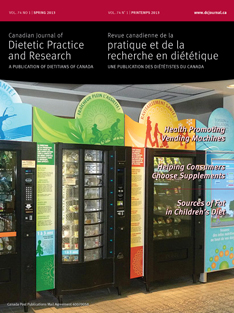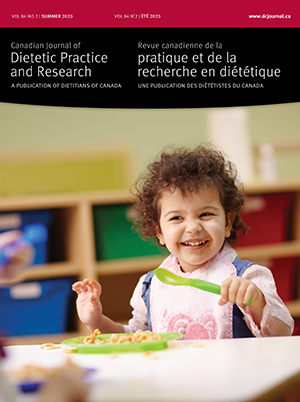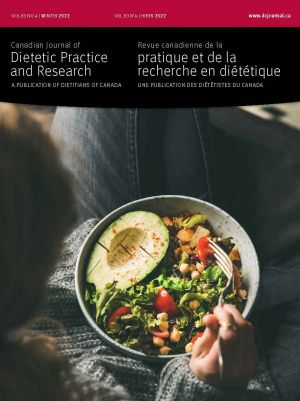Volume 74 • Number 1 • March 2013
Chair’s Message
Editor’s Message
Research
Purpose: Amounts and sources of trans fatty acids (TFA) and saturated fatty acids (SFA) were examined in the diets of children aged five to six years after changes in TFA in Canadian foods. Methods: Dietary intake was assessed for 100 Vancouver children, using three 24-hour recalls during parental interviews. Trans fatty acid and SFA intakes and food sources were determined for each child. Results: The TFA intake was 0.71 ± 0.31% of energy, and 12% of children consumed over 1% of energy from TFA. Saturated fatty acids intakes were 12.5 ± 3.39% of energy, and 81% of the children consumed more than 10% of energy from SFA. Monounsaturated and polyunsaturated fatty acid intakes were 12.0 ± 3.0% and 5.79 ± 2.16% of energy, respectively. Major sources of TFA were dairy products, fast foods, and bakery products. Major sources of SFA were dairy products, processed foods, fast food, and bakery products. Conclusions: The TFA intakes of children aged five to six years have decreased since 2004 to a 95th percentile intake of 1.28% of energy, but more than 80% of children consume over 10% of energy from SFA. Removing TFA from snacks and bakery products would decrease the highest TFA intakes to 1% of energy. This study suggests that increased efforts by industry or educational guidance for parents is required to enable selection of foods lower in TFA, and that greater emphasis is needed on SFA.
Purpose: We examined the facilitators of and barriers to participants’ application of cooking skills beyond Cook It Up!, a pilot community-based cooking program targeting at-risk youth aged 13 to 18. Methods: Photovoice is a qualitative research method using still-picture cameras to document participants’ health and community realities. Four participants photographed items they perceived as facilitators of or barriers to the application of cooking skills. At a facilitated discussion group, youth discussed why they took certain pictures and how the photos best exemplified facilitators and barriers. Participants agreed upon the themes arising from the dialogue. Data trustworthiness tools were used to ensure that themes arising from the dialogue truly represented participants’ perspectives. Results: Four major themes emerged as facilitators: aptitude, food literacy, local and fresh ingredients, and connectedness. Access to unhealthy foods was the only barrier that participants identified. Participants and researchers decided to advocate for the sustainability of community-based cooking programs offered for high school credit. Participants’ photos would enhance advocacy efforts with education stakeholders. Conclusions: Cook It Up! provided youth with cooking techniques for healthy, economical, homemade meals, but proof was needed of the transferability of skills outside the program environment. Youth in this study identified important facilitators that enabled the continued use of their cooking skills, and one barrier. Findings underscore the importance of communitybased cooking programs tailored to at-risk youth.
Purpose: The association between preference for and intake of fruits and vegetables was examined among Albertan children. Methods: Data used were collected as part of a provincial population-based survey among grade 5 children in Alberta. Intake of two fruits and five vegetables was assessed using the Harvard food frequency questionnaire, and preference for individual fruit and vegetable items was rated using a three-point Likert-type scale. Random effects models with children nested within schools were used to test for associations between fruit and vegetable preference and intake. Results: A total of 3398 children aged 10 to 11 years returned completed surveys. Children who reported a greater liking for fruits and vegetables also reported significantly (p<0.001) higher intake. On average, children who liked a food a lot ate 0.5 to 2.7 more weekly servings of the food than did children who did not like the food. Conclusions: These findings suggest that focusing on interventions designed to increase taste preference may lead to increased fruit and vegetable intake among children. Introducing children to unfamiliar fruits and vegetables through taste testing may be an effective and practical health promotion approach for improving dietary habits.
Purpose: Taking advantage of a natural experiment made possible by the placement of health-promoting vending machines (HPVMs), we evaluated the impact of the intervention on consumers’ attitudes toward and practices with vending machines in a pediatric hospital. Methods: Vending machines offering healthy snacks, meals, and beverages were developed to replace four vending machines offering the usual high-energy, low-nutrition fare. A pre- and post-intervention evaluation design was used; data were collected through exit surveys and six-week follow-up telephone surveys among potential vending machine users before (n=293) and after (n=226) placement of HPVMs. Chi-2 statistics were used to compare pre- and post-intervention participants’ responses. Results: More than 90% of pre- and post-intervention participants were satisfied with their purchase. Post-intervention participants were more likely to state that nutritional content and appropriateness of portion size were elements that influenced their purchase. Overall, post-intervention participants were more likely than pre-intervention participants to perceive as healthy the options offered by the hospital vending machines. Thirty-three percent of post-intervention participants recalled two or more sources of information integrated in the HPVM concept. No differences were found between pre- and postintervention participants’ readiness to adopt healthy diets. Conclusions: While the HPVM project had challenges as well as strengths, vending machines offering healthy snacks are feasible in hospital settings.
Purpose: In Canada, many people do not meet all the recommended nutrient intakes with food alone; the use of supplements may be one strategy to compensate for some of these inadequacies. Previous research has revealed several barriers to supplement use, including a lack of knowledge. In this qualitative study, we developed a resource to help inform and educate consumers on the selection of appropriate nutrition supplements. Methods: Three focus groups with participants residing in low-income neighbourhoods in Saskatoon, Saskatchewan, and seven key informant interviews were conducted using a semistructured interview guide and four resource examples. After transcription of the discussion and interviews, thematic analysis was used to identify emergent themes. Results: Analysis yielded three overarching themes: barriers to use, interdisciplinary issues, and resource expectations. Each overarching theme had several subthemes. Subthemes of the overarching theme of resource expectations were subsequently used to create a new tool to help consumers select an appropriate multivitamin. Conclusions: A tool was developed after available resources were explored and stakeholders were interviewed. The new resource was based on community members’ and health care professionals’ expressed needs, ideas, and beliefs.
Purpose: We assessed the impact of a nutrition program implemented in Nunavik childcare centres on Inuit children's food and dietary intakes. Methods: Two hundred and forty-five Inuit children (aged 25.0 ± 9.6 months) were recruited between 2006 and 2010 in Nunavik childcare centres. Dietary intakes were assessed using a single 24-hour dietary recall (n=217). We compared participants’ energy and nutrient intakes, and the proportions who met iron requirements and Canada's Food Guide – First Nations, Inuit and Métis recommendations, depending on whether or not they attended a childcare centre during the 24-hour dietary reference period. Results: Children who attended a childcare centre on the day of the recall had significantly higher intakes of omega-3 fatty acids, calcium, total iron, bioavailable iron, phosphorus, betacarotene, folate, pantothenic acid, riboflavin, and vitamin K, while a higher proportion of them met the recommended intake for total and bioavailable iron. The proportion of children who met the recommended servings for vegetables and fruit, grain products, and milk and alternatives was also significantly higher among participants who attended a childcare centre. Conclusions: The nutrition program was effective at improving these Inuit preschoolers’ diet.
Perspectives in Practice
Health literacy has the potential to improve an individual’s capacity to access, understand, evaluate, and communicate basic health information and services in order to make appropriate health decisions. We developed a research agenda to help older adults become aware of health literacy and its function in promoting their nutritional health and well-being. A key activity is the development, implementation, and evaluation of an eHealth literacy tool, eSEARCH, targeted at older adults to help improve their eHealth literacy skills. Before consultations were held with this subpopulation to assess their eHealth literacy needs and abilities, key informant interviews were conducted with eight experts in the field of health literacy, the older adult population, and/or online communications. Some experts were identified from the relevant literature; others were identified by informants who had already been interviewed. Informants were asked nine questions about the perceived importance of health literacy in Canada, key considerations in developing an eHealth literacy tool, and supporting resources for advancement of the eHealth literacy tool. Informants agreed that health literacy is a key concept and stressed that key considerations for development of the eSEARCH tool are identifying the target population’s needs, focusing on health promotion, and increasing confidence in information-seeking behaviours. Identified challenges are ensuring accessibility, applicability to older adults, and adoption of the tool by dietetic and other health care professionals.
Report
Purpose: Dietetics students’ reservations about their career choice were investigated. Methods: In several dietetics programs in various provinces, an in-class or online survey was administered to students in the early or late stages of their education (n=397). Data were coded and analyzed, using descriptive statistics. Chi-square testing for independence was used to establish significant relationships. Results: Forty-three percent (n=149) of those responding to the research question (n=344) indicated they had reservations about a dietetics career, primarily because of internship, salary, and employment concerns. Students enrolled in a coordinated internship/degree program experienced no reservations about internship. Students experienced fewer career reservations when they had made their career decision before grade 12, were influenced by a dietitian, or were in the later stages of their education. Conclusions: Findings have implications for dietetics recruitment, retention, research, and education. An understanding of sources of reservations about career choice will allow policymakers, researchers, and educators to address issues to ensure that potential professionals are well informed about career components and that educational programs meet students’ needs.
Purpose: The popularity of bottled water products (BWPs) is growing in Canada. Concentrations of minerals with important implications for health were compared in different types of BWPs. Methods: One sample of each brand and type of plain BWP (purified, remineralized, spring, mineral, and artesian), flavoured BWP, and nutrient-enriched BWP sold in major stores in Ottawa, Ontario, was purchased to allow determination of mineral concentrations by flame atomic absorption or emission spectroscopy. A total of 124 BWPs representing 37 brands were analyzed. Results: In general, spring and mineral water contained higher amounts of magnesium and calcium than did purified, remineralized, artesian, flavoured, or nutrient-enriched water. Most plain BWPs contained little sodium and potassium, whereas 15% to 35% of flavoured and nutrient-enriched products had considerably higher concentrations. Only magnesium and calcium concentrations were highly correlated (r=0.76, p<0.001). Calculation of the percentage of Dietary Reference Intakes that could be supplied by each product revealed that, if they are consumed habitually, many products can contribute substantially to recommended intakes of these minerals. Conclusions: Mineral concentrations in most types of BWP varied, but distinct differences between types of products were identified. Consumers should be aware of the mineral content of BWPs because some could influence intakes of certain minerals significantly.










